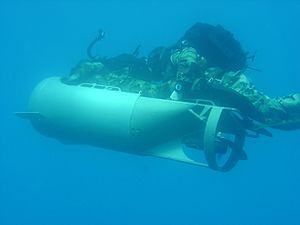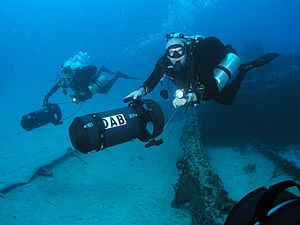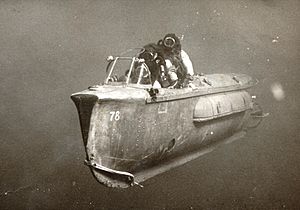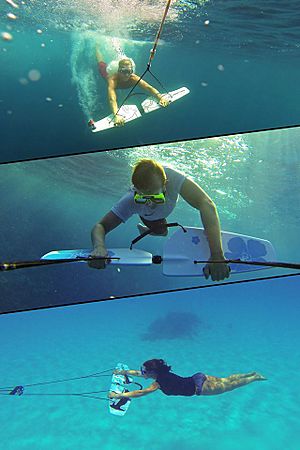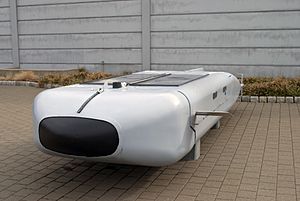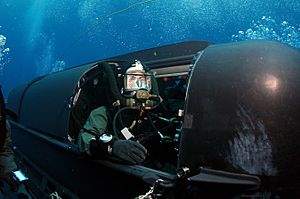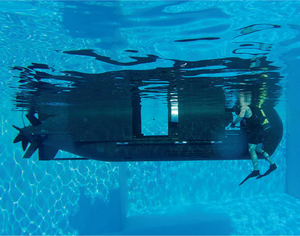Diver propulsion vehicle facts for kids
A diver propulsion vehicle (DPV) is a cool piece of diving equipment. It's also called an underwater scooter or sea scooter. Scuba divers use DPVs to move faster and go further underwater.
Think of it like an underwater bike! It helps divers cover more distance without getting tired. How far a diver can go depends on how much air they have, how fast they use it, and the DPV's battery life. DPVs are used for fun, for science, and even by the military.
DPVs come in different sizes. Some are small and easy to carry, perfect for short trips. Others are much bigger and can carry several divers for long distances at high speeds. The very first DPVs were used for military missions during World War II. They were based on torpedo technology.
Contents
How DPVs are Built
A DPV usually has a strong, waterproof case. Inside, there's an electric battery that powers a motor. This motor spins a propeller to push the DPV through the water.
Designers make sure the propeller is safe. It can't hurt the diver, their gear, or marine life. The DPV also needs to be safe from accidentally starting. It should also float just right underwater, not sinking or floating too much. This is called being neutrally buoyant.
What DPVs are Used For
DPVs are super helpful for divers who want to explore more. They let divers go further than they could by just swimming. This is because swimming uses up air faster and makes divers tired. DPVs also help divers manage their time underwater, especially on deep dives. Deep dives often have strict time limits because of decompression rules.
Divers often use DPVs for cave diving or technical diving. These dives can be long and challenging. DPVs help carry heavy equipment. They also make the most of the limited time divers have underwater. For military divers, DPVs help them travel long distances quickly. This allows them to carry their gear for special missions.
DPVs can also have cool accessories. Divers can attach lights, compasses, or even video cameras to them. Using a DPV on deep dives can also make it safer. It reduces the risk of breathing too fast from working hard.
Things to Watch Out For
Using a DPV means you need to be extra aware of your surroundings. Things can happen much faster underwater! Divers need to control their depth, adjust their buoyancy, watch their air supply, and navigate all at once.
Controlling your buoyancy is very important. A DPV can help you move up or down quickly. But if you stop, you might float up or sink too fast if you haven't adjusted your buoyancy. Moving too fast up or down can be dangerous. It could cause injuries or decompression sickness.
Traveling at high speeds in tight spaces or murky water can be risky. You might hit something, which could cause injury or damage. Also, many small sea creatures hide or are camouflaged. Moving fast and making noise can scare them away. DPVs are also bulky and can make it hard to move precisely. This is especially true for things like close-up photography.
Since you're not kicking, you might get colder faster. This is because less physical activity and more water flow. Divers can wear warmer wetsuits to help with this. If you rely on a DPV to get out of a long cave, always have a backup plan. You need to be able to get out safely if the DPV breaks down. Using a DPV adds more tasks for the diver. This can sometimes distract them from other important things. Also, the DPV's thrust can stir up silt from the bottom. This can make the water cloudy and hard to see.
History of DPVs

The first DPVs were called human torpedoes or manned torpedoes. They were secret naval weapons used during World War II. These were used by Italy and later Britain in the Mediterranean. They attacked enemy ships in harbors.
The first human torpedo was the Italian Maiale ("Pig"). It was carried by a submarine close to the target. Two crew members in diving suits rode on top of it. They steered the electric torpedo slowly to the target. They would then attach the detachable warhead (the explosive part) to the ship like a limpet mine. After that, they would ride the torpedo away. The front of the torpedo was filled with explosives. It was designed to be hung under a ship's bottom.
The Italian navy used this idea very successfully early in World War II. The British copied it after Italy damaged two British battleships and a tanker in Alexandria harbor. The Italians officially called their craft "Slow-running torpedo." But the operators nicknamed it "Maiale" because it sounded like a pig. The British versions were called "chariots".
Another cool historical DPV was the Motorised Submersible Canoe (MSC). It was nicknamed Sleeping Beauty. British Special Operations Executive (SOE) built it during World War II. It was an underwater vehicle for one frogman. Its job was to do secret reconnaissance or attacks on enemy ships.
Types of DPVs
Diver-Tugs or Scooters
The most common type of DPV is a "scooter." The diver holds onto handles at the front or back. The scooter pulls the diver along. Divers usually wear a harness. A leash connects the scooter to the harness with a quick-release clip. This lets the diver stay parallel to the scooter for the best movement.
Swimmer Delivery Vehicles (SDVs)

SDVs are like small, wet submarines. They are designed to carry frogmen (combat divers) and their gear underwater over long distances. SDVs have a pilot, a co-pilot/navigator, and a team of combat swimmers. They take the team to their mission targets on land or at sea. The pilot and co-pilot are often part of the swimmer team. A good example is the SEAL Delivery Vehicle used by the United States Navy SEALs.
For long missions, SDVs carry their own air supply. This helps the divers save their own scuba air. SDVs are often used to secretly drop off special forces. They also plant limpet mines on enemy ships. They can land a team on a hostile shore for missions. After the mission, the team can return to the SDV to be picked up. SDVs can also plant mines and then escape before the explosives go off. This can also trick enemies about where an attack is coming from. Some SDVs, like the Mark 9 SEAL Delivery Vehicle, could even fire torpedoes. This let them attack from far away.
The idea for SDVs came from the Italian human torpedoes and the British Motorised Submersible Canoe from World War II.
Manned Torpedoes
These DPVs look like torpedoes or fish. One or more divers sit on top of them or inside hollow parts. Human torpedoes were very effective for commando frogmen in World War II. They sank many ships in the Mediterranean. Similar vehicles have been made for work divers or sport divers. These don't have warheads and are more streamlined.
Some modern scooters are torpedo-shaped. They have handles near the front and a raised seat at the back. Other designs, like the Russian Protei-5, have the diver attached to the top.
Subskimmers
The Subskimmer is a special kind of DPV. It's a rigid-hulled inflatable boat (RIB) that can also go underwater. On the surface, it uses a petrol engine. When it goes underwater, the engine is sealed. Then it runs on battery-electric thrusters. It can inflate and deflate itself. This lets it change from a fast surface boat to an underwater DPV.
Wet Subs
As DPVs get bigger, they start to become like submarines. A wet sub is a small submarine where the inside is filled with water. The crew must wear diving gear. The military uses wet subs for secret missions. They deliver and pick up operators in harbors without being seen.
Towed Sleds
These are unpowered boards, usually rectangular, that a boat pulls. They work like underwater wings. The diver holds onto the sled. They can use a quick-release tether to reduce tiredness. Divers control their depth by changing the angle of the board. They are sometimes called manta-boards, like the manta ray. Towed sleds are good for exploring or searching in clear water. The boat controls the main path, but the diver can move up, down, and side to side a bit.
Modern DPVs Today
Many countries use different types of DPVs today. Here are a few examples:
Italy
- Cosmos CE2F series: A DPV designed for two people.
Poland
- Błotniak: A DPV designed for one person.
Russia/USSR
- Protei-5: A DPV for one person that clips onto the diver.
- Sirena DPV: A Soviet human torpedo about 8 meters long. It can carry two divers. It can travel about 11 nmi (20 km) at 2-4 knots, up to 40 meters deep. It can be launched from a submarine's torpedo tube.
- Project 907 Triton 1: A 1.6-ton Soviet DPV for two crew members who ride on top. It can rest on the seabed for up to 10 days. It's 5 meters long and can go 35 nmi (65 km) at 6 knots, up to 40 meters deep.
- Project 908 Triton 2: A larger 5.3-ton Soviet DPV that can carry 6 crew members. It's a wet sub, but it keeps a constant pressure inside. It's 9.5 meters long and can go 60 nmi (111 km) at 6 knots, up to 40 meters deep.
Sweden
A Swedish company, Defence Consulting Europe Aktiebolag (DCE AB), makes modular SDVs. They are all based on the same design.
- SEAL carrier: A two-person SDV that can go over 30 knots on the surface. It can also be parked on the seafloor. It has different modules for various missions, like carrying swimmers or acting as an underwater robot.
- Smart SEAL: A smaller version of the SEAL Carrier.
- Sub SEAL: An electric SEAL carrier that can dive 40 meters. It carries 6 divers and has a range of 30 nmi (56 km) at 5 knots.
- Torpedo SEAL: An SDV designed to fit inside a 21-inch torpedo tube. It comes in one-person (2.5 m) and two-person (3.4 m) versions.
United Arab Emirates
Emirate Marine Technologies makes four types of DPVs/SDVs from strong composite materials.
- Class 4: A three-ton DPV for two people. It uses batteries to power an 8 kW motor. It has sonar, GPS, and electronic maps. It can go 60 nmi (110 km) at 6 knots (max 7 knots) and dive up to 50 meters.
- Class 5: An eight-ton DPV for two people, similar to Class 4 but can carry more weight.
- Class 6: A DPV/SDV being developed to carry 4 or 8 divers (with 2 crew). It will have electric motors for underwater and a diesel engine for surface use. It will have an autopilot and cameras. It will have a range of 100 nmi (185 km) at 4 knots underwater and a top speed of 20 knots on the surface.
- Class 8: An 11-meter long DPV/SDV being developed for 6 divers (2 crew). It will be powered by two 8 kW motors and a lithium-ion battery. It will have a range of 50 nmi (93 km) at 5 knots.
United States
- Piranha: A 1.63-ton DPV/SDV for two people, made of fiberglass. It can go 27.5 nmi (51 km) at 5 knots, with a burst speed of 8 knots. It can dive up to 70 meters.
- SDV-X Dolphin: A 2.75-ton SDV for 6 to 8 people, also made of fiberglass. It can go 56.5 nmi (104.5 km) at 5 knots, with a burst speed of 8 knots. It can dive up to 91 meters. It has modern electronics like color displays, GPS, and sonar.
- Sea Shadow SDV: A 107 kg DPV for one or two crew, powered by lead-acid batteries. It's made of plastic to have a low magnetic signature. It can be launched through a small hatch. It has electronic speed control and shows speed, depth, and battery life. It has a range of 5 nmi (9.25 km) at 2 to 3 knots and a maximum depth of 30 meters.
- SEAL Delivery Vehicle (SDV): The Mark 8 SDV has a top speed of 6 knots (11 kph) and a range of 36 nautical miles (66 km) at a depth of 6 meters. It is currently used by the US Navy.
- Shallow Water Combat Submersible: This is planned to replace the SEAL Delivery Vehicle. It can last 12 hours and carry more weight over longer distances.
Yugoslavia
The DPVs from former Yugoslavia were developed by Brodosplit.
- R-1: A 150 kg, one-person torpedo-like SDV. The operator rides on top. It can carry 40 kg of limpet mines. It's 3.72 meters long and can fit in a submarine torpedo tube. It has a range of 8 nmi (14.8 km) at 2.5 knots and a maximum depth of 60 meters.
- R-2 Mala: A 1.41-ton, two-person SDV. The crew rides on top. It has a 4.5 kW electric motor. It can go 23 nmi (43 km) or 46 nmi (85 km) depending on batteries. Its cruise speed is 2.8 knots, and max speed is 6.5 knots. It has navigation gear like a compass and sonar. It can operate down to 60 meters and carry up to 250 kg of mines.
See also
 In Spanish: Vehículo de propulsión para buceo para niños
In Spanish: Vehículo de propulsión para buceo para niños
- Cosmos CE2F series
- Błotniak
- Protei-5 Russian diver propulsion vehicle
- Dive Xtras
- Chinese diver propulsion vehicles
- SEAL Delivery Vehicle
- Advanced SEAL Delivery System
- Al-Sabehat



